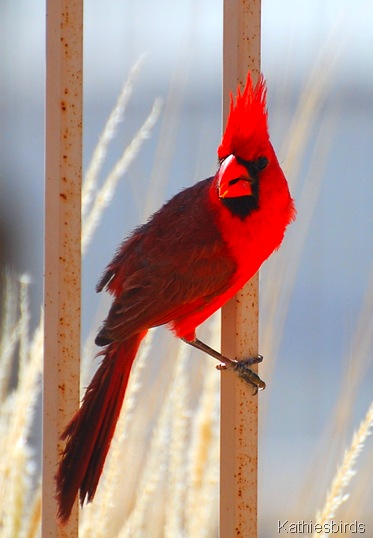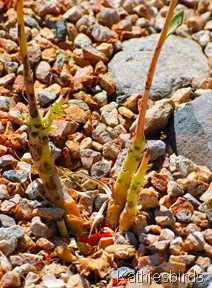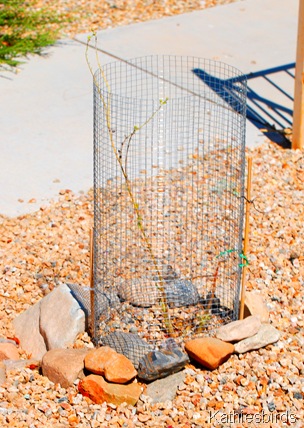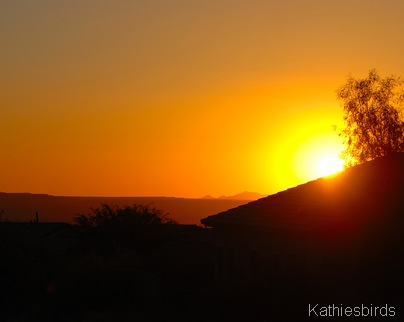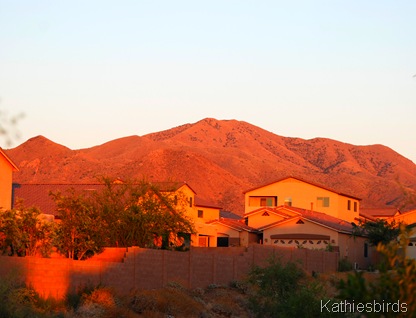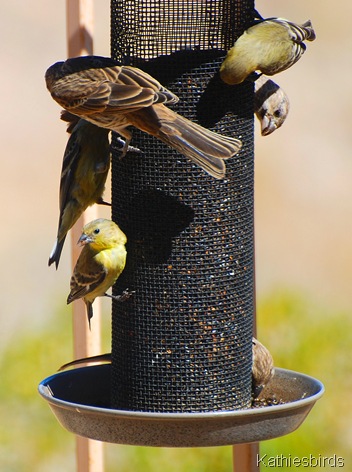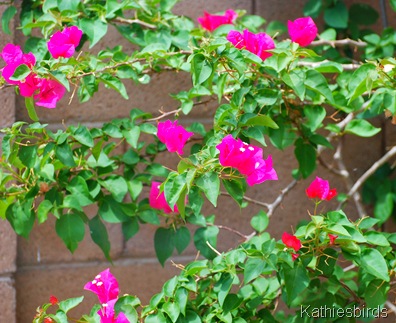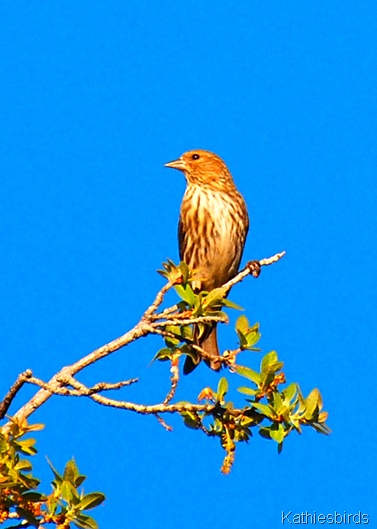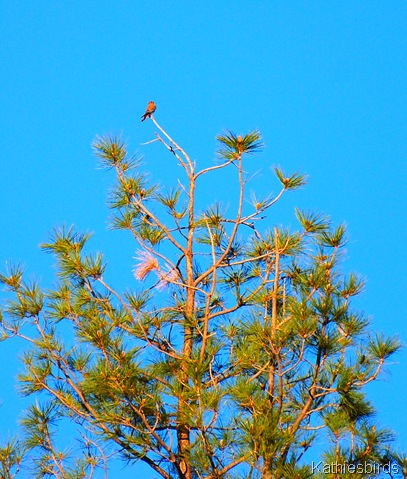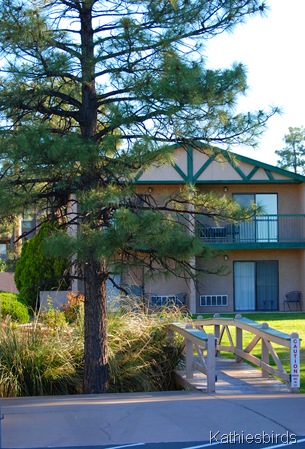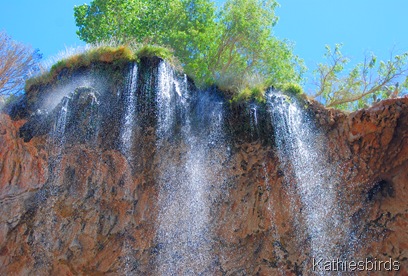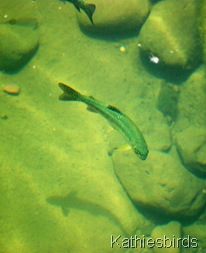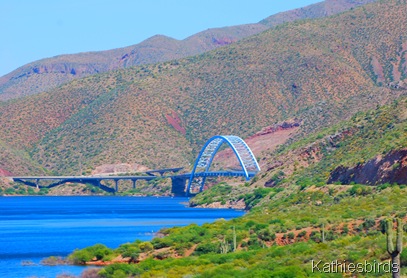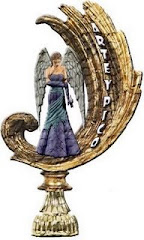 Desert Willows are some of the only flowers still blossoming in this 100 plus degree heat while The Desert Waits for rain. Taken 6-3-10.
Desert Willows are some of the only flowers still blossoming in this 100 plus degree heat while The Desert Waits for rain. Taken 6-3-10.
Friday, June 25, 2010
Skywatch Friday: Desert Willow Blossoms
 Desert Willows are some of the only flowers still blossoming in this 100 plus degree heat while The Desert Waits for rain. Taken 6-3-10.
Desert Willows are some of the only flowers still blossoming in this 100 plus degree heat while The Desert Waits for rain. Taken 6-3-10.
Thursday, June 24, 2010
Around the Yard in Sycamore Canyon
Male Cardinal 6-22-10
The quail block attracts more than just quail…
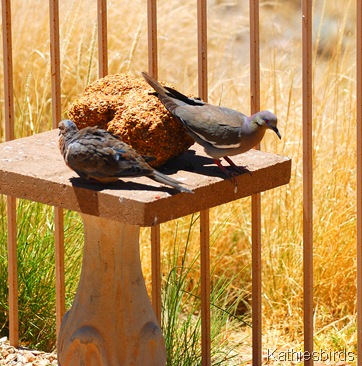 Mourning dove and White-winged dove 6-18-10
Mourning dove and White-winged dove 6-18-10
 Antelope Ground Squirrel 6-22-10
Antelope Ground Squirrel 6-22-10

 Here is one solution to my ant problem. I put a saucer of water beneath the feeder so that when the Gila Woodpeckers land on it and it drips, not only is the nectar diluted but the water is also so deep that the ants drown in it. So far it seems to be working. That’s a Costa’s hummingbird coming in for a drink in the photo.
Here is one solution to my ant problem. I put a saucer of water beneath the feeder so that when the Gila Woodpeckers land on it and it drips, not only is the nectar diluted but the water is also so deep that the ants drown in it. So far it seems to be working. That’s a Costa’s hummingbird coming in for a drink in the photo.
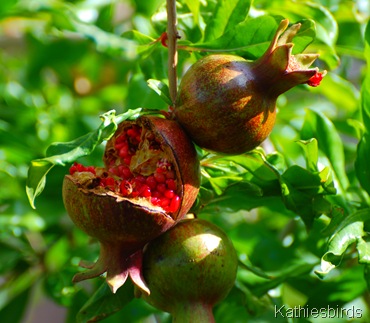 My Pomegranate tree has grown like a big weed! It was full of blossoms and now it is bursting with the ripening fruit. The birds seem to love it as well. Soon all the desert will be bursting with ripening prickly pears. I think I may have to make jelly again this year!
My Pomegranate tree has grown like a big weed! It was full of blossoms and now it is bursting with the ripening fruit. The birds seem to love it as well. Soon all the desert will be bursting with ripening prickly pears. I think I may have to make jelly again this year!
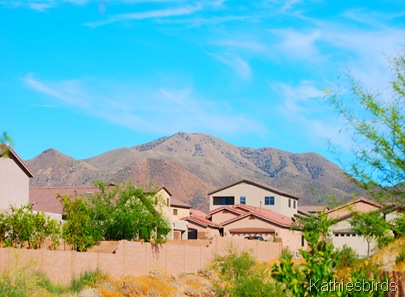 A few wispy clouds float by over the top of Mount Fagan to tempt and tease us, but the dew temperature needs to rise and the wind needs to change directions before the Monsoon will bring us sweet relief.
A few wispy clouds float by over the top of Mount Fagan to tempt and tease us, but the dew temperature needs to rise and the wind needs to change directions before the Monsoon will bring us sweet relief.
Wednesday, June 23, 2010
Today in Sycamore Canyon
Today in Sycamore Canyon the sun continues to blaze. At 1:30 PM MST it is 102F degrees. However, this Mourning Dove has figured out how to stay cool. But the need for water drives the birds to desperate measures.
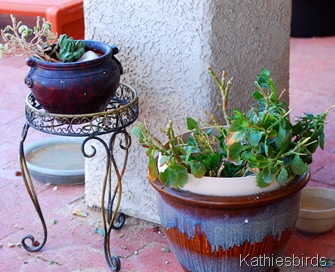 My succulents have been stripped of their juicy leaves…
My succulents have been stripped of their juicy leaves…
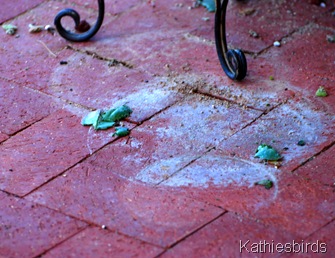 … the leaf debris is scattered on my patio.
… the leaf debris is scattered on my patio.
Out front my newly planted purslane is being gobbled away.

I should have done this long ago but today I am finally fighting back. I do not know if birds or beasts are eating my purslane but I am trying to save it. We shall see what happens.
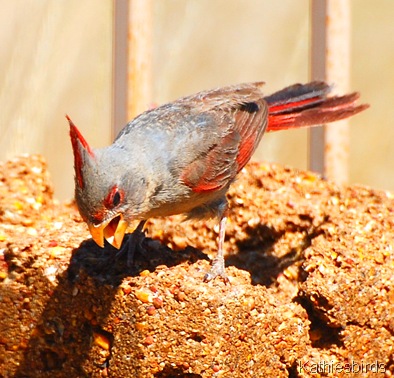 Meanwhile, even the pyrrhuloxias are desperate for food. This young female is trying to break free some seed from the seed block. Food is scarce in the desert now. We are all waiting for rain.
Meanwhile, even the pyrrhuloxias are desperate for food. This young female is trying to break free some seed from the seed block. Food is scarce in the desert now. We are all waiting for rain.
Monday, June 21, 2010
Natalie
Natalie 6-21-10
 Gus, Diane, Alex, and Natalie 6-20-10
Gus, Diane, Alex, and Natalie 6-20-10
My son, Alex and his family arrived on Father’s Day to spend his last leave with us before he is shipped off to Afghanistan. This is our last time to see him and we are soaking up every minute we can. If you don’t hear from me for awhile, this is why.
Friday, June 18, 2010
Skywatch Friday: Roosevelt Bridge
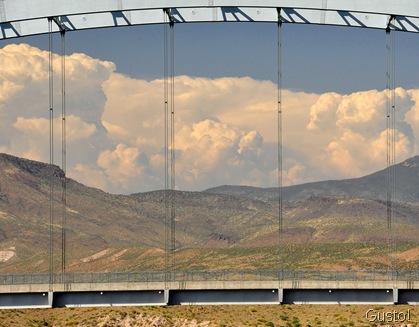 Thunderheads building behind the mountains as seen through wires of the Roosevelt Bridge in Arizona 6-6-10 Photo taken by Gus with the Nikon D90 and the 18-200mm lens.
Thunderheads building behind the mountains as seen through wires of the Roosevelt Bridge in Arizona 6-6-10 Photo taken by Gus with the Nikon D90 and the 18-200mm lens.
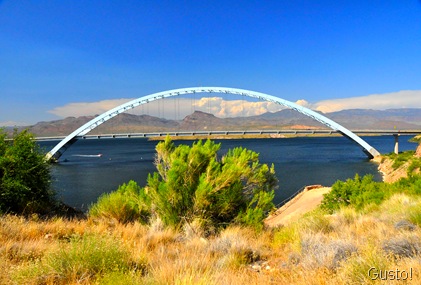 Roosevelt Bridge 6-6-10 by Gus with the Nikon D90, 18-200mm lens.
Roosevelt Bridge 6-6-10 by Gus with the Nikon D90, 18-200mm lens.
We stopped by Inspiration Point near the Roosevelt Dam on our way home from our anniversary weekend in Payson, AZ. It was 108 degrees F and very windy when Gus took these pictures. Please click on the pictures to enlarge for the best view.
Wednesday, June 16, 2010
The Desert Waits
It is the hot time of the year now. Every morning I wake up and fill bird baths and water flowers. The brittle bush has dried. The grasses are drying. The afternoon sun blazes like a flaming sword. Ocotillo have dropped their leaves. The ground lies parched and the desert is waiting.
The mornings are the best time of the day while the air is still cool and the birds are still active. I find my feeders full most mornings and I delight in the antics of the birds. Parents are bringing chicks to the feeders. I have seen Gilded Flickers feeding chicks in my yard as well as curve-billed thrashers and Gambel’s Quail. There are the usual House Finches and House Sparrow chicks as well as Lesser Goldfinches. Recently the young Verdin have been arriving with their plain gray heads and wide mouths with a bit of the yellow gape of a juvenile still showing at the corners. Costa’s Hummingbirds are returning after being absent for almost 2 months during their breeding season. I had taken down all but 3 of my feeders but now I fight with the ants to keep them full for the hummingbirds. I can barely stand to see the hummingbirds come and hover near where a feeder used to be and have them finding nothing. I have taken pains to plant vegetation that would be attractive to hummingbirds and so have seen them feeding from the Whirling butterflies (guara), salvia and honeysuckle.
But in the afternoon, the birds pant from the heat. They seek refuge in the shade of my covered patio and eat the swollen green leaves of my potted succulents. I have one with the common name of “Bear paws” that I do not think will survive their hunger and thirst. House Finches can be ravenous eaters of greenery as I previously learned. The birds are waiting.
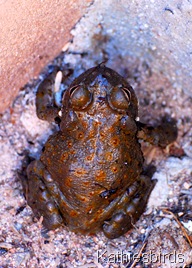 The toad I mentioned in a previous post was here again the next day and I was able to get its photograph. It is a young Sonoran Desert Toad but apparently it is camera shy for I had not seen it since I took this picture until tonight when I heard and then saw it hopping about in the flowerbed beneath the mesquite tree. As long as it eats crickets, it is welcome here! But the Sonoran Desert Toads have not started to sing their desert song yet. They need the Monsoon rain to bring on their frantic mating cries. This young toad in my yard is here because I water my plants and it is deceived into thinking the Monsoon has come, but the wise adults have not emerged in the rest of the desert. The Sonoran Desert Toads are waiting.
The toad I mentioned in a previous post was here again the next day and I was able to get its photograph. It is a young Sonoran Desert Toad but apparently it is camera shy for I had not seen it since I took this picture until tonight when I heard and then saw it hopping about in the flowerbed beneath the mesquite tree. As long as it eats crickets, it is welcome here! But the Sonoran Desert Toads have not started to sing their desert song yet. They need the Monsoon rain to bring on their frantic mating cries. This young toad in my yard is here because I water my plants and it is deceived into thinking the Monsoon has come, but the wise adults have not emerged in the rest of the desert. The Sonoran Desert Toads are waiting.
Though the afternoon grew hotter and hotter I barely noticed as I stayed inside and worked with the air conditioning running but as evening came on I went outside to watch for nighthawks skimming insects from the air, and though I watched for 20 minutes after sunset I only saw one bird. Now the night has fallen, a crescent moon hangs in a velvet sky, and a cool breeze wafts over the yard and plays around the corners of my house. Soon the Milky Way will rise and brighten this dark and cloudless night. The Monsoon officially started yesterday but there is no rain in sight. Until the dew point rises to 54 degrees for 3 days in a row and the wind changes directions and flows from the east we are in Monsoon Season in name only and like the rest of the desert, all I can do is wait.
Monday, June 14, 2010
I Will Sip Sweet Wine in the Desert
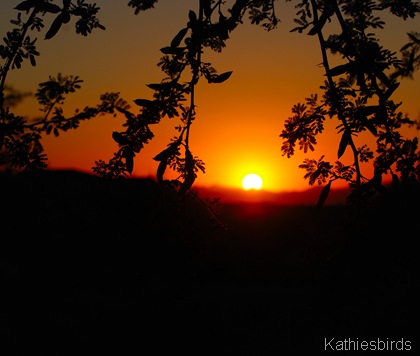 Sycamore Canyon Sunset 6-14-10
Sycamore Canyon Sunset 6-14-10
It’s the end of another busy day in Sycamore Canyon. All day I have watched the birds in my yard feeding their young, feeding themselves, and drinking from the water fountain or birdbath. Water is very scarce at this time of year and it will often draw birds into the yard that seeds and suet do not. I saw an ash-throated flycatcher land on the block wall this afternoon but when it saw me it did not venture into the yard. I am still doing battle with ants but I think I have the bees outfoxed for now. The battle with the ants would be a bit easier of the Gila woodpeckers did not hang from the feeders and spill nectar on the ground or the table!
We have had a bit of a break from the heat here in Sycamore Canyon over the weekend and even today the air was comfortable in the shade. I love living here because I can be outdoors at almost any time of the year. The heat rarely drives me inside anymore since I can sit under my covered patio in the shade. I have amazing birds in my yard almost every day and now and then a few surprises to boot. The diversity of wildlife, plants and birds is absolutely amazing. Since moving here I have heard coyotes howl and Sonoran Desert toads sing. In the summer I watch nighthawks and purple martins flutter through the sky, in the winter I see raptors hunt my bird feeders and land within feet of my den window. In 30 seconds I can be out the front door and in the canyon walking amongst cacti, creosote bush, mesquite and Palo Verde. Red cliffs tower above me while deep sand and gravel crunches beneath my feet. I am lost and found in the desert. It is a place to love.
Tonight I will sit on the patio and sip sweet wine as the sun sets in the west casting its rose-gold glow onto the slopes of Mt. Fagan. I am thinking about my life here and all that it means to me.
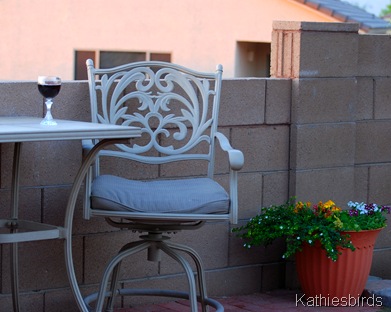 Sweet Wine in the Desert 6-14-10
Sweet Wine in the Desert 6-14-10
Sweet Wine in the Desert
I will sip sweet wine in the desert
While the nighthawks fly through the sky
And black-throated sparrows sing their silvery song
as the sunlight slips from the sky
‘till purple dusk over takes me
And the stars twinkle into the night
I will sip the sweet wine of the desert
As I slip into this desert life.
~kathiesbirds (6-14-10)
Thursday, June 10, 2010
Today in Sycamore Canyon
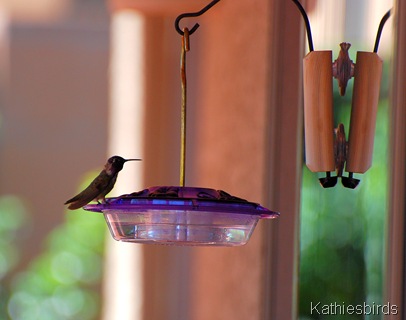
Today in Sycamore Canyon the Costa's hummingbirds are back. I have been seeing males for the most part for the past couple of weeks, but today a female Costa's showed up. I love feeding hummingbirds but the feeders do present a challenge. Not only do bees tend to hover around them at certain times, but now I am busy fighting ants drawn to the sugary syrup. I used to have a different feeder here on the window under the covered patio over my patio table because hummingbirds like to feed in the shade and this arrangement keeps them dry when it rains. The other feeder I had was the inversion type where you flip it over to fill it and then invert the bottle for the birds to feed. The problem is that with the high temperatures we have been having lately the nectar is forced out of the bottle do to the increased pressure when the liquid inside expands, thus dripping all over my table and attracting ants. So, for now I am trying this type of feeder in this location which is a saucer feeder and tends to discourage ants and bees. However, the Gila woodpeckers may still hang from it to feed which will also cause it to drip and then I will have to think of something else!
Meanwhile, I still have the inversion type of feeders elsewhere in my yard. The ants have also found these and are climbing the shepherds hooks I have them on, as well as the glass window where my window feeder is held on by suction cups. In my war against the ants I have tried several things. First I broke down and sprayed a chemical spray after removing all feeders and plants from the area. I immediately felt guilty for this and washed it all away. While it killed the ants I could see, it didn’t stop them from coming back later in the day. Then I tried ant traps. It was all well and good until fresh nectar dripped on the table. The ants bypassed the bait and went straight for the sugar-water! What now? Well, I changed the feeder as stated above. I tired spraying the ants with my white vinegar solution I use to clean the windows with. It killed the ants but didn’t keep them from coming back. So, I am now trying this…
 Vaseline and Vicks Vaporub on the pole…
Vaseline and Vicks Vaporub on the pole…
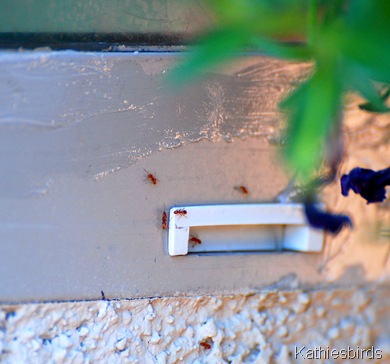 and around the edges of the window. So far they will not cross this and they seem to hate the odor of the vaporub but will it also chase away the birds? I am watching and waiting. I have taken great precautions to make sure that none of this will end up on the wings of the birds which could be disastrous! I’ll let you know how it all turns out.
and around the edges of the window. So far they will not cross this and they seem to hate the odor of the vaporub but will it also chase away the birds? I am watching and waiting. I have taken great precautions to make sure that none of this will end up on the wings of the birds which could be disastrous! I’ll let you know how it all turns out.
Meanwhile…
… as well as this baby curve-billed thrasher being fed by its parent.
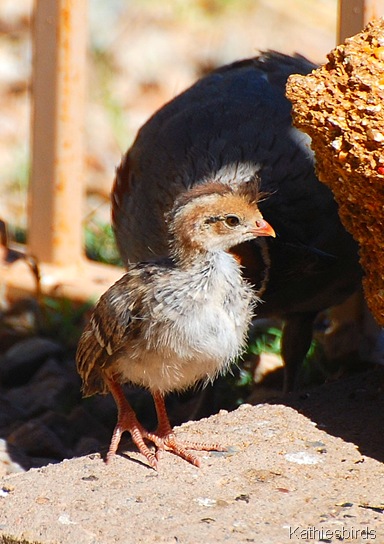 The Baby Gambel’s Quail are starting to arrive…
The Baby Gambel’s Quail are starting to arrive…

My bougainvillea in bloom today.
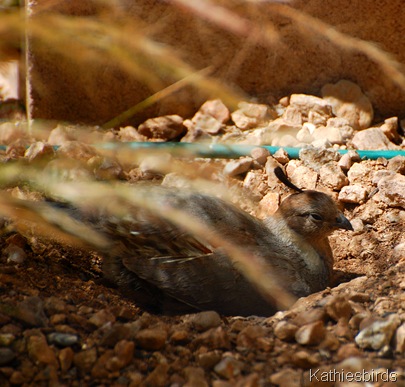 Female Gambel’s Quail digging herself a nest hole beneath the nearby grass and bougainvillea!
Female Gambel’s Quail digging herself a nest hole beneath the nearby grass and bougainvillea!
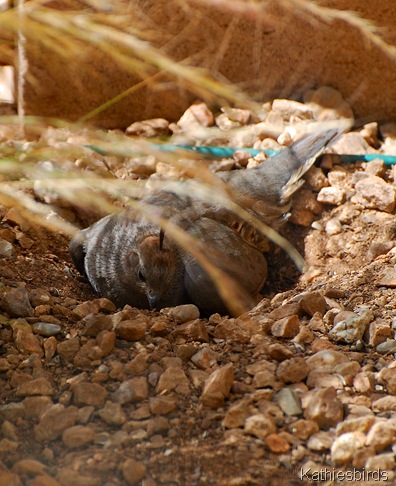 She’s just relaxing and cooling off and apparently eating in bed!
She’s just relaxing and cooling off and apparently eating in bed!
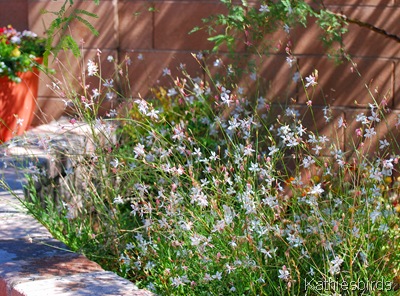 In the backyard the whirling butterflies (guara) are in bloom…
In the backyard the whirling butterflies (guara) are in bloom…
 And while I was watering my garden I saw a toad disappear into this hole beneath the spigot! I planted Irish moss here to catch the drips of water from the hose. It seemed a good idea and so far it is growing but apparently a toad has decided it makes a perfect home. I tired to flush it out for a look by filling the hole with water. No luck…
And while I was watering my garden I saw a toad disappear into this hole beneath the spigot! I planted Irish moss here to catch the drips of water from the hose. It seemed a good idea and so far it is growing but apparently a toad has decided it makes a perfect home. I tired to flush it out for a look by filling the hole with water. No luck…
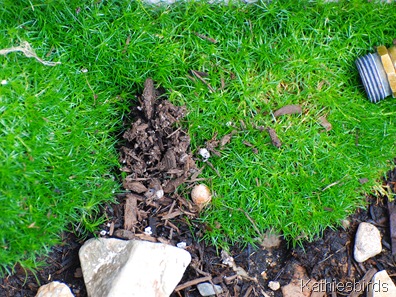 …but when I came back later on in the afternoon I noticed the hole plugged up with debris. Seems the toad shut the door on me! One question: Since he lives in Irish Moss, does that make him an Irish toad?
…but when I came back later on in the afternoon I noticed the hole plugged up with debris. Seems the toad shut the door on me! One question: Since he lives in Irish Moss, does that make him an Irish toad?
Hot, sunny, and windy here in Sycamore Canyon today. It was 77 degree F when I first got up at 7:30 a.m. but has now risen to 102 degrees F. A few clouds are wafting overhead and the wind has picked up quite a bit. It is suppose to blow quite fiercely over the next few days and the temperature is suppose to drop into the high 80’s! That is almost unheard of for June and will be a relief after the triple digit temperatures we have been having as of late.
Today in Sycamore Canyon I am also thinking of fellow blogger, birder, and artist Debby Kaspari. Debby and her husband Mike had their home and studio destroyed last month in an F4 tornado in Oklahoma. Julie Zickefoose has written a fantastic article about it on her blog with links to where you can donate if you are interested. Please take a look and see if you would like to help. Debby and Mike escaped with only their lives and their cat. Click on the links below to read the amazing stories and see photos for yourself. Debby, I wish you all the best. May you start painting again soon for all of us and For the Birds!
Debby’s Blog: Drawing the Motmot
Wednesday, June 9, 2010
Postcard from Payson, AZ and Beyond
Pine siskin at the Pine Trailhead near Pine, AZ 6-5-10
With temperatures heading into the rang of 105 degrees farenheight this weekend and the fact that is was our 33rd anniversary we decided to head for the hills and celebrate in Payson, AZ just below the Mogollon Rim. We had never been to Payson, which is in Gila County, and I had only counted birds in Gila County once last year when I barely drove into it after a trip to Boyce Thompson Arboretum. Back then I only counted 15 species of birds. Now I was going to have the chance to up that total as well as escape the heat AND spend quality time with my sweetheart. So, on Saturday morning with our reservation made we jumped in the car and drove the 3 1/2 hours to Payson.
Kestrel in a Pine 6-5-20 at the Pine Trailhead
Once we left Phoenix the drive became scenic and we thoroughly enjoyed ourselves. After checking into the hotel we immediately went out exploring and ended up 14 miles north of Payson at the Pine Trailhead just south of Pine, AZ. Here the trees towered over us and the birds flew around us.
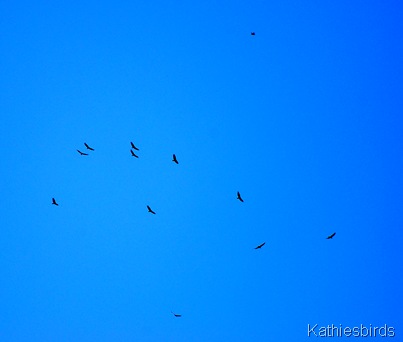 A kettle of turkey vultures gathers overhead. I count at least 18 birds in the sky. Ash-throated flycatchers call from a clearing and a red-shafted northern flicker lands on the ground nearby. We spend about 35 minutes here just in the parking area and I count a total of 14 species of birds.
A kettle of turkey vultures gathers overhead. I count at least 18 birds in the sky. Ash-throated flycatchers call from a clearing and a red-shafted northern flicker lands on the ground nearby. We spend about 35 minutes here just in the parking area and I count a total of 14 species of birds.
Back at our hotel I hear a bird calling and find a spotted towhee in the trees near the little bridge. The next morning it is there again along with white-breasted nuthatches and a Say’s Phoebe. While Gus sleeps in, I decided to drive down to Green Valley Park at the end of Historic Main Street to see what birds are out and about.
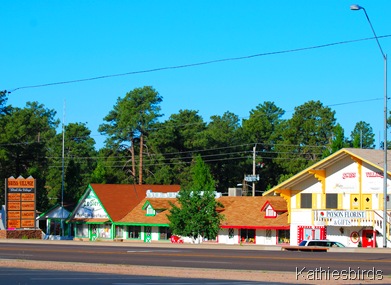 I drive past the Swiss Village which is across the street from the Payson Inn where we are staying and down the Beeline Highway to Main St.
I drive past the Swiss Village which is across the street from the Payson Inn where we are staying and down the Beeline Highway to Main St.
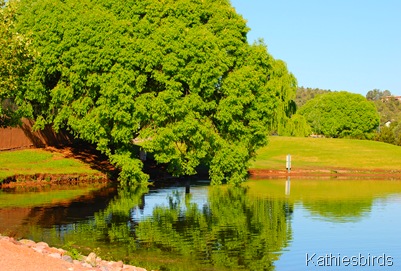 After turning west I arrive at the park with its lush green lawns and three ponds. I park by the main pond and start counting birds.
After turning west I arrive at the park with its lush green lawns and three ponds. I park by the main pond and start counting birds.
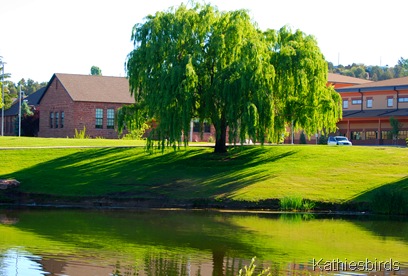 There are people out fishing from the docks already and birds flitting about in the trees. Lesser goldfinches twitter and squeak, Great-tailed grackles whistle and call. A great blue heron is busy doing its own fishing in one of the smaller ponds across the street while barn swallows swoop above the blue waters. In the shade of this weeping willow I find two black phoebes hunting insects along the water’s edge. It is so peaceful here and so lush compared to the Sonoran desert where I now live.
There are people out fishing from the docks already and birds flitting about in the trees. Lesser goldfinches twitter and squeak, Great-tailed grackles whistle and call. A great blue heron is busy doing its own fishing in one of the smaller ponds across the street while barn swallows swoop above the blue waters. In the shade of this weeping willow I find two black phoebes hunting insects along the water’s edge. It is so peaceful here and so lush compared to the Sonoran desert where I now live.
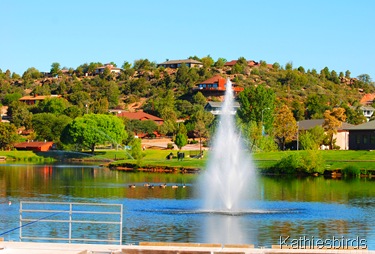 I like the feel of the trees and the mountains. I liked the park with its fountains and green banks. People are emerging from their homes with their dogs. I swear everyone in this town has a dog. I don’t think I saw anyone walking or driving without a dog on a leash or in their car!
I like the feel of the trees and the mountains. I liked the park with its fountains and green banks. People are emerging from their homes with their dogs. I swear everyone in this town has a dog. I don’t think I saw anyone walking or driving without a dog on a leash or in their car!
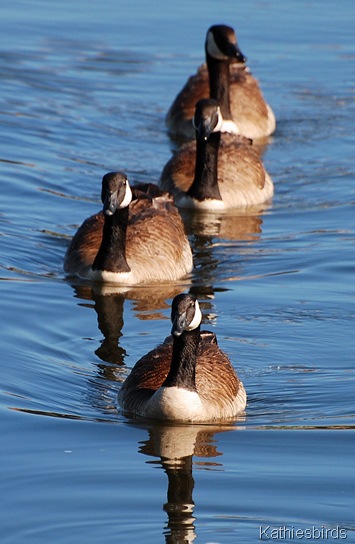 But I am here to see birds. When Gus and I stopped by here yesterday I saw mallards and they are still here today, but this time a small flock of Canada geese comes swimming towards me. It would be fanciful of me to imagine they are here to greet me, but the truth is, I think they are looking for a handout. Well, sorry to disappoint you birds, but you are on your own! I have been here for a half an hour and realize I need to get back to Gus and the hotel so we can eat breakfast and get on the road.
But I am here to see birds. When Gus and I stopped by here yesterday I saw mallards and they are still here today, but this time a small flock of Canada geese comes swimming towards me. It would be fanciful of me to imagine they are here to greet me, but the truth is, I think they are looking for a handout. Well, sorry to disappoint you birds, but you are on your own! I have been here for a half an hour and realize I need to get back to Gus and the hotel so we can eat breakfast and get on the road.
 After a continental breakfast at the hotel we check out and head north once again to Tonto Natural Bridge State Park. We tried to visit the night before but arrived just before it closed at 6 p.m. So, we are back today to see what we can see. The temperature is already rising at 10:30 a.m. and it feels so hot!
After a continental breakfast at the hotel we check out and head north once again to Tonto Natural Bridge State Park. We tried to visit the night before but arrived just before it closed at 6 p.m. So, we are back today to see what we can see. The temperature is already rising at 10:30 a.m. and it feels so hot!
Tonto Natural Bridge is the largest travertine arch in the world. At 183 feet high and 150 feet wide at its widest point, it has an international reputation and draws over 100,000 visitors a year. We drive to the far end of the parking lot where you can get a very good view of the arch from above. The best view is from below however, but you have to hike down a half mile very steep trail. Gus decides to stay up top, but I take my chances and scramble down with bins, camera and water.
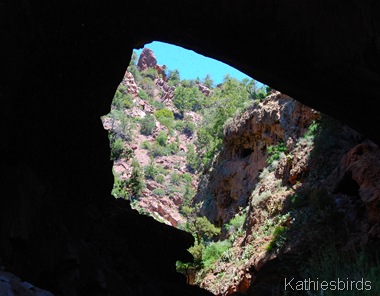 This is a view looking through the arch.
This is a view looking through the arch.
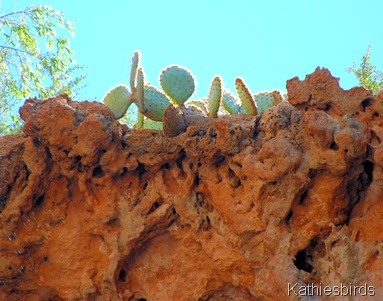 Though pines, cottonwoods and sycamores rise around me, this prickly pear on the cliff reminds me that I am still in the desert.
Though pines, cottonwoods and sycamores rise around me, this prickly pear on the cliff reminds me that I am still in the desert.
I look above me to the cliff edge where water spills in a glistening curtain to the creek below. Above me the sky is filled with White-throated swifts twittering and darting about. They are joined by a few cliff swallows as well and I am surprised when they suddenly break into a fight with cliff swallows diving at the backs of the swifts! Across the creek I hear a brown-crested flycatcher calling, waking up the forest with its raucous cries.
The fish in the creek are undisturbed by its calling. I watch fascinated from the bridge they swim in the cool depths of the water. I would like to linger here. I wish that Gus could have made it down here with me to see this for himself. Perhaps we will come back when it is cooler. I start the hike back up, stopping several times along the way to rest with sweat pouring form my body. My hair is damp and my skin is hot. My camera and bins grow heavier with each step. I drink the rest of my water just before I reach the top where I find Gus sitting at a picnic table waiting for me in the shade. We get in the car and blast the AC. From what the locals tell me, it is not normally this hot here.
We drive back to Payson stopping along the way for me to count birds by a creek while Gus naps in the car. After lunch at the Payson Airport’s Crosswinds Cafe where we have an awesome view of the Mogollon Rim we start on our way home. As we leave Payson I remark to Gus that this is a lot like being in New Hampshire only without the mosquitoes, black flies, humidity or snow! We decide to take the scenic route home instead of going back through Phoenix, so south of Payson we turn off AZ Highway 87 onto AZ highway 188 which takes us past Roosevelt Lake. The temperature, which was 94 in Payson at 2:00 PM, now rises to 104, then 106, then 108! I have been up since 6:30 a.m. and though I love to look out the windows wherever we travel anywhere, I soon drifted off to sleep. Suddenly Gus wakes me and stops the car in the middle of the road and I am glad he does. Before me the clear blue waters of Roosevelt Lake sparkle in the blazing sunlight…
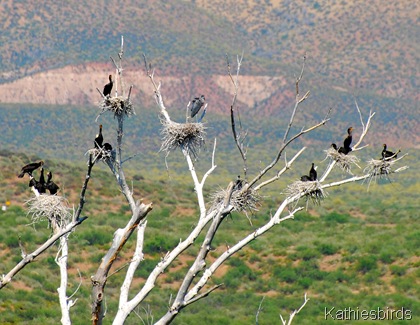 …and just beyond the road at the edge of the reservoir in a collection of dead trees there are dozens and dozens of cormorants nesting along with a great-blue heron or two. The sight is simply amazing and I am wide awake now. We are both amazed by the brilliant blue water and in spite of the heat soon hop out to take pictures.
…and just beyond the road at the edge of the reservoir in a collection of dead trees there are dozens and dozens of cormorants nesting along with a great-blue heron or two. The sight is simply amazing and I am wide awake now. We are both amazed by the brilliant blue water and in spite of the heat soon hop out to take pictures.
Roosevelt Lake is quite long and we drive mile after mile past the sparkling waters which look so cool and inviting to me. How I would love to get down there and swim! Ahead of us we see a blue arch rising and we soon realize we will be crossing this beautiful bridge.
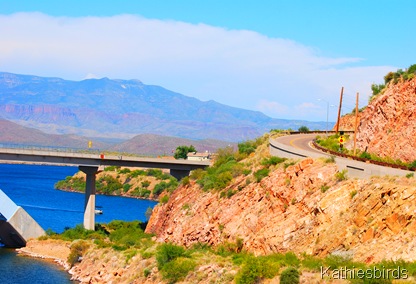 We cross the bridge then take the turn to Inspiration Point where we have a great view of the dam and the bridge. From reading the informational sign I learn that this is the largest single span arch bridge in he world! In 1995 is was named one of the Top 12 Outstanding Bridges in America along with the Brooklyn Bridge and the Golden Gate Bridge. It is 108 degrees outside with wind blowing at a speed strong enough to keep a flag unfurled. Yet we are captured by this beauty and we vow to come back again soon, though hopefully when it is cooler!
We cross the bridge then take the turn to Inspiration Point where we have a great view of the dam and the bridge. From reading the informational sign I learn that this is the largest single span arch bridge in he world! In 1995 is was named one of the Top 12 Outstanding Bridges in America along with the Brooklyn Bridge and the Golden Gate Bridge. It is 108 degrees outside with wind blowing at a speed strong enough to keep a flag unfurled. Yet we are captured by this beauty and we vow to come back again soon, though hopefully when it is cooler!
 North end of the bridge which we had just driven over 6-6-10.
North end of the bridge which we had just driven over 6-6-10.
Gus got some amazing photos and he said this was his favorite part of the trip. I will post his pictures in a separate post. This was definitely the long way home but so pretty. We had a great time! As for me, I bumped my Gila County Bird List from 15 species to 43! However, I was quite surprised that I did not see any warblers anywhere. I did hear some bird calls that I could not identify, but I never got my eyes on the birds.
Birds seen in Gila County in July 2009:
- Mourning dove
- Cactus Wren
- House finch
- Great-tailed grackle
- Gambel’s quail
- Eurasian-collared dove
- Northern Cardinal
- house sparrow
- white-winged dove
- turkey vulture
- common raven
- lesser goldfinch
- Verdin
- rock pigeon
- red-tailed hawk
Birds seen in Gila County on this trip June 2010:
- Say’s Phoebe
- House sparrow
- turkey vulture
- House finch
- common raven
- spotted towhee
- Eurasian-collared dove
- American robin
- barn swallow
- western kingbird
- mallard
- rock pigeon
- great-tailed grackle
- great-blue heron
- Cassin's kingbird
- bullock’s oriole
- acorn woodpecker
- American crow
- Pine siskin
- lesser goldfinch
- bridled titmouse
- Violet-green swallow
- American kestrel
- Ash-throated flycatcher
- White-breasted nuthatch
- pygmy nuthatch
- Northern flicker
- mourning dove
- Canada goose
- Northern rough-winged swallow
- Black phoebe
- white throated swift
- Cassin’s finch
- Brown-crested flycatcher
- Phainopepla
- Cliff swallow
- Double-crested cormorant
